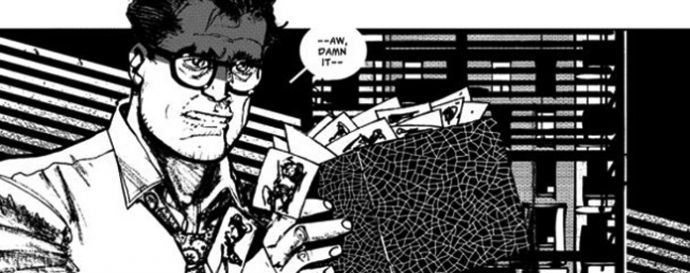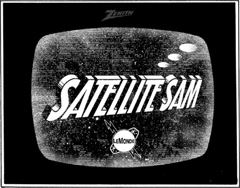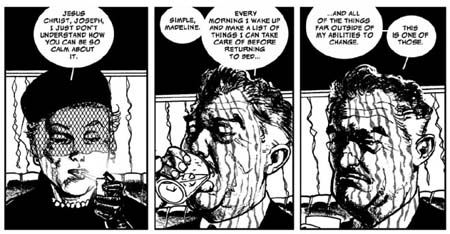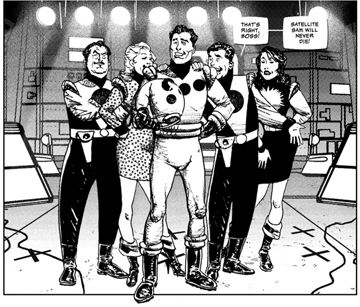- Comics
- Comics Reviews
- Manga
- Comics Reviews
- European Comics
- News
- Comics News
- Press Releases
- Columns
- Spotlight
- Digital Comics
- Webcomics
- Cult Favorite
- Back Issues
- Webcomics
- Movies
- Toys
- Store
- More
- About

By Philip Schweier
July 30, 2015 - 15:16
After more than a year, I finally took the time to consume
the entire Satellite Sam series in a single sitting. I always wait for a
story to run its course before reading it. One might suggest I just wait for
the trade, but if I bypass the monthlies in favor of a trade, there might not
be one. And in this case, at 15 issues, I’m not sure how thick a trade to
expect. Fifteen may seem like a peculiar number, but to the credit of those
involved, that’s simply how many it took to tell the story. There is no padding
to reach 18, making for the usual six-issue volumes.
While the title might suggest the heroic tale seen in most comics,
it is in fact a good old-fashioned mystery, set against the backdrop of the
earliest days of television. Perhaps as a reflection of it’s setting, the story
is told in black and white.

Carlyle White is the star of Satellite Sam, a children’s space adventure
series produced by the LeMonde Network. When he is found dead in a love nest,
his son, Mike, is determined to crawl out of his bottle in an effort to find
the who, why and how of his father’s death. Aiding Mike is Kara Kelly, his
father’s one time squeeze and now the star of LeMonde’s religious programming.
She also has alcohol issues, but they seem to be headed in the opposite
direction.
As Mike is drafted to fill his father’s shoes as the star of Satellite Sam, he
begins looking for answers behind Carlyle’s death. The authorities seem willing
to write it off as a sexcapade gone wrong, but Mike needs to know more. As he
digs, he uncovers various layers of bribery, corruption and depravity within
the Lemonde network.
Meanwhile, there’s a mad scramble behind the scenes, as Dr. Joseph Ginsberg,
head of the network, attempts to exert a little influence (i.e., blackmail)
with the FCC to take the LeMonde nationwide. Libby Meyers, White’s personal
assistant, merely wants to put on a good show. Guy Roth, Satellite Sam’s
head writer, would be happy to accommodate her, if he weren’t battling
Ginsberg’s efforts to keep him in the closet, while simultaneously being
blackmailed by two-bit supporting actors threatening to expose him.
Each of the main characters has their role to play, and is provided ample time
on the page to contribute to the narrative. As with most people, they display
moments both crass and compassionate. Even Carlyle White, portrayed in
flashbacks, earns some sympathy, rather than serve as just another dead perv
who got what’s coming to him.
The story is written by Matt Fraction, whose work I am unfamiliar with – though
that will soon change. A mystery enthusiast myself, I think Satellite Sam
is an excellently written tale that measures up to any book or movie in the
genre. I look forward to exploring more of Fraction’s library of work.
It is drawn by Howard Chaykin, whose work I am very familiar with.
It’s no secret around these parts that I am a big fan, though not so enamored
that I find everything he does to be pure gold. He’s produced his share of less
satisfying material over the years, but that would not include Satellite Sam. Period pieces have become
Chaykin’s stock in trade, and his extensive research into the clothing,
technology, and overall environment adds a remarkable “you are there” quality
to the artwork.

As for the near-absence of color, I believe many artists today rely very
heavily on it, and consequently are unsure of themselves when that element is
removed from their artwork. If Chaykin has any such doubts (not likely), it
doesn’t show in the least.
Together, Fraction and Chaykin have dissected a unique slice in 20th century
history, one seldom seen in the wake of bigger events. One of the elements I
appreciated about the series was that it relied mostly on setting and dialogue,
with little to no internal monologues like we often see in comics today.
Aiding and abetting is Chaykin’s long-time collaborator Ken
Bruzenak, whose lettering and design add additional layers of graphic
storytelling. Dialogue and pictures can only go so far in depicting events on
the page; even the placement of the most minor of sound effects can pull the
reader deeper into the story.

Satellite Sam features a great deal of sexual content, which may
contribute to a more limited release in trade paperback form. I would recommend
any comic book reader interested in a fascinating mystery drama start gathering
back issues while ye may.